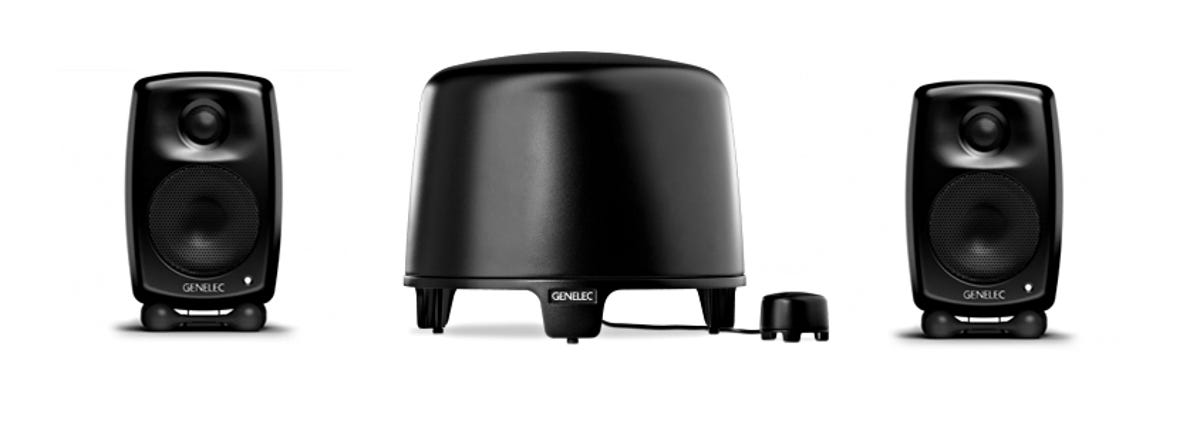
Genelec
I love desktop speakers — correction — I love great-sounding desktop speakers. Decent ones start around $200 a pair, and my reference Adam Audio F5s run $500 for a pair. Desktop speakers are designed to be listened to from three to six feet away, and when you’re that close, you hear more of the sound directly from the speakers than you ever will from hi-fi or home-theater speakers. When you’re further away from the speakers, your room’s reflective surfaces — walls, floor, ceiling, and other objects in the room — muddy the sound. Stereo imaging can get confused and blurry, but up close the stereo imaging is razor sharp.
Which brings us to the little Genelec G One: this monitor is the real deal. It’s a close cousin of the 8010A monitor that Genelec sells to professional sound engineers all around the world. The company offers a vast range of desktop and large studio monitors. I last wrote about Genelec in 2012, when I checked out a set of their smallest pro monitors at the Audio Engineering Society show in New York. But for this review of the G One, I requested a pair to try at home. They’re really tiny speakers, so I also ordered the matching F One subwoofer. The G Ones aren’t strictly desktop monitors; this Genelec system can also be used in home theater and hi-fi systems in small rooms. Of course, Genelec also offers a range of larger speakers for midsize and large rooms.
The G One has a .75-inch tweeter and 3-inch woofer, each driver is powered by a separate, built-in 12-watt amplifier. Obviously, Genelec isn’t playing a numbers game to wow potential buyers with impressive specifications. I will say the die-cast aluminum cabinet feels super solid; it stands 7.3 inches tall, perched on the included Iso-Pod isolation base. Connectivity options are limited to one RCA input. The F One subwoofer houses a down-firing 6.5-inch woofer, powered by a built-in 40-watt amplifier. The 10-inch tall, aluminum-and-steel cabinet has a bass port and five channels of input and output RCA jacks on its bottom panel. The F One provides bass management for all of the speakers hooked up to it (with a fixed 85 Hertz crossover). The sub comes with a remote control to adjust the volume of a complete desktop, stereo, or home-theater system. The G One and F One are built in Genelec’s factory in Finland and available in painted semi-matte black or white finishes.
The first thing I noticed about the G One’s sound was how articulate it is. Drums and other percussion instruments’ dynamic contrasts are vividly presented — the G One’s resolution and clarity are truly exceptional. You hear how everything — the good, bad, or ugly — sounds in your recordings. Play an audiophile recording, and you’ll hear how good it really is, while nasty and harsh recordings sound nasty and harsh. The Genelecs tell it like it is. Adam Audio F5 speakers, Emotiva Airmotiv 5s, and Audioenigne A5+ speakers all produce a lot more bass than the G Ones, and they’re more forgiving, so it’s easier to enjoy less-than-stellar recordings with those other speakers. The Genelecs are considerably more transparent and neutral sounding speakers.
I listened to the G Ones for a few hours without a subwoofer and really liked the sound, but I also really like bass, so I added the F One subwoofer. Wow — the sub takes the sound to the next level by extending the low bass response down to 35 Hertz. The blend between the sub and satellite speakers was good, but bass between 60 and 80 Hertz was a little lightweight. I tried adjusting the F One’s controls, but the bass in that range was still too light. I’ve noted similar bass limitations with other desktop sub systems. Deeper bass below 60 Hz was plentiful with the F One. Every room’s acoustic balance is different, so the G One/F One combination may produce a smoother response in other rooms.
On my desktop, the G One/F One’s sound was right up there with the best desktop speakers I’ve heard at home. True, Genelec’s low power ratings for the speakers and sub’s amps limit maximum volume capability, but in fact, the Genelecs played as loud as I would ever want, sitting just 30 inches away from the speakers. Jack White’s new “Lazaretto” album lit up the G One/F One big time — these little speakers can rock out. Their poise under pressure was impressive.
I next set the Genelecs up in my bedroom to try them out in a two-channel home theater. I ran stereo audio from my TV to the sub and speakers. First up, the plane crash scene from “Flight of the Phoenix,” mostly because I’ve used it on countless sound-bar and home-theater reviews. The G One/F One did a good job; clarity and dialogue intelligibility were all first rate, but the ferocious impact of the plane wasn’t as powerful as I expect from an expensive 2.1 channel home-theater system like this. Much better home-theater sound is available from larger speakers and subs, such as the Tekton M Lore towers ($650/pair) and Hsu Research VTF-1 Mk2 sub ($459), but the G One/F One is worth considering if you need really tiny speakers, or you don’t crave the utmost in visceral impact. I was using just a pair of the G Ones, but you can hook up five G One speakers to the sub, and more speakers would certainly improve the home-theater experience.
Its home-theater sound was good, but the G One/F One pairing on my desktop was superb. The G One retails for $395 each, and the F One is $795.




